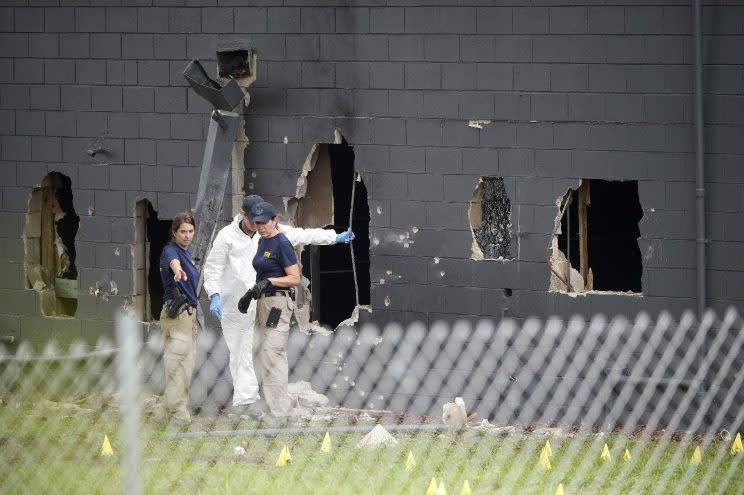Survivors of massacre question Orlando police delay in storming nightclub

Some survivors of the mass shooting at a gay nightclub in Orlando are joining critics who say the three hours police spent negotiating with the gunman before storming the building was too long.
“I was yelling at the cops,” Angel Colon, who was shot five times during Sunday’s attack inside the Pulse nightclub before he was dragged to safety, told Fox’s “Good Day New York.” “I didn’t understand why they didn’t go in. There is no reason why they should be standing there with all these gunshots going off. I have videos of me yelling at the cops to go in there.”
Jeannette McCoy, who was with Colon at the club and able to escape before the standoff, also questioned how the police handled the situation.
“Why couldn’t we have taken care of this much earlier? There were people in there bleeding to death,” McCoy told the New York affiliate. “A part of me puts a sense of blame on them. I’m sorry, but I was there. They could have done something.”
The gunman, 29-year-old Omar Mateen, opened fire inside the club shortly after 2 a.m., authorities and witnesses say. An off-duty police officer who was working as a security guard just outside Pulse’s entrance confronted Mateen and exchanged gunfire, and the shooter ran back inside, holing up in a bathroom, where police say he was holding several hostages.
Shooting at Pulse Nightclub on S Orange. Multiple injuries. Stay away from area. pic.twitter.com/5Di2mc6XUY
— Orlando Police (@OrlandoPolice) June 12, 2016
But more than three hours passed before a SWAT team successfully breached the wall of the club with an armored vehicle, engaged Mateen in a shootout as he tried to flee and killed him, putting an end to a massacre that left 49 dead and 53 wounded — the deadliest mass shooting in U.S. history.
Several experts said the delay may have contributed to the death toll.
“Action beats inaction 100 percent of the time,” Chris Grollnek, an active-shooter expert and a retired police officer and SWAT team member, told the Associated Press. “When we see SWAT teams respond and not making entry [it] creates victims. Period. End of story.”
Grollnek told the New York Daily News that the police response in Orlando “was a catastrophic failure.”
“Police are trained that if there’s an active shooter in progress, you go in and confront the shooter at any risk,” he said. “When an active shooter is shooting, you go in and shoot the shooter.”
On Monday, Orlando Police Chief John Mina defended the decision to wait, saying they believed Mateen — who called 911 several times during the standoff — had explosives inside.
Scott Reitz, a retired Los Angeles police SWAT team firearms and tactics instructor, told LA Weekly that Mina made the right call.
“If an individual goes in and rigs the place with explosives and you breach it, everybody gets blown to bits,” Reitz told LA Weekly. “You inadvertently set off an IED.”
“The train of thought is, ‘If he’s calling, maybe we can negotiate. Maybe we can get him to surrender,'” Reitz continued.
Crisis negotiators said Mateen was calm when they spoke with him, but when he asserted his intent to kill more people, Mina decided to go in.
“We believed further loss of life was imminent,” Mina said. “It was a hard decision to make, but it was the right decision. Our No. 1 priority is on saving lives, and it was the right decision to make.”
Ed Allen, training program manager at the National Tactical Officers Association, said it was a textbook case.
“If there is a window of opportunity for us to resolve the situation peacefully, we’ll take advantage of it,” Allen told the New York Times. “But when the suspect escalates the level of violence, we are forced to intervene.”
But Louis R. Anemone, a former chief of department for the NYPD, told the newspaper the situation in Orlando wasn’t so clear.
“Is it an active shooting case or a hostage case? It’s a very fine line,” Anemone said. “What are the facts initially? If there were shots being fired inside when the police arrived, they had a moral obligation to go in.”
Orlando police first tried to breach an exterior wall with an explosive device, but the hole wasn’t big enough, Mina said. So a BearCat was used to punch a 2-by-3-foot hole in the wall about 2 feet off the ground.
“We were able to rescue dozens and dozens of people who came out of that wall,” Mina said. “The suspect came out of that hole himself with a handgun and a long gun and engaged in a gun battle with officers where he was ultimately killed.”
“If you waited and he didn’t kill more people, it was the right call,” Reitz said.
Mina, though, said it was possible that some victims may have been killed by officers during the shootout with Mateen.
“That’s all part of the investigation,” Mina said. “But I will say when our SWAT officers, about eight or nine officers, opened fire, the backdrop was a concrete wall and they were being fired upon.”
Related slideshows:
Slideshow: Victims of the Florida nightclub shooting >>>
Slideshow: Front page coverage of the Orlando mass shooting >>>


